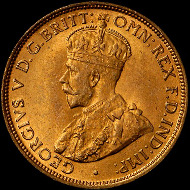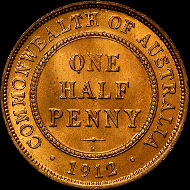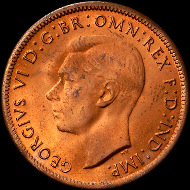May 1, 2014 – The Numismatic Guaranty Corporation (NGC) has certified the superb Benchmark Collection, a complete set of Australian pre-decimal coins. The collection includes a number of finest known examples and important rarities as well as several previously undocumented varieties.
Australia 1912 H Halfpenny | NGC MS 66. The private Heaton Mint in Birmingham was sub-contracted by the Royal Mint to strike the entire mintage of Australian halfpennies in 1912 and 1915 and in 1914 it struck coins in conjunction with the London Mint. The halfpennies struck in Birmingham were all distinguished by an ‘H’ mint mark. Source: NGC.
The Benchmark Collection stands as the most significant set of Australian pre-decimal coinage ever assembled. Mark Duff of Strand Coins in Sydney, Australia, carefully compiled the collection over a period of 25 years, drawing coins from many of the most important collections of Australian coins.
“NGC had previously graded a number of my clients’ most important and valuable Australian coins and I have long been impressed by their accuracy and consistency, and their enthusiasm to expand the knowledge of this series,” says Duff. “NGC was the only choice to certify the Benchmark Collection.”
Among the many highlights of the Benchmark Collection is the 1916M sixpence graded NGC MS 68. The finest NGC-certified Australian sixpence of any date, this impeccable specimen traces its pedigree to the important Parkhill Collection.
Remarkably, the sixpence series also includes three examples graded NGC MS 67: the 1917M, the 1934 and the 1936. All three specimens are the finest known of their date.
The Benchmark Collection’s run of florins is similarly notable for its quality. The 1914H and 1915 florins, both graded NGC MS 65, are the only Mint State examples of their dates to be certified by NGC. The 1915H in NGC MS 67 is the finest certified by four grade points, while the 1923 in NGC MS 67 is the finest certified by three grade points.
Other significant florins in the Benchmark Collection include the 1911, 1912 and the ex-Parkhill 1919 – all graded NGC MS 65 and either the highest graded or tied for the highest graded. The 1934-35 Victoria & Melbourne Centenary florin graded NGC MS 65 is also noteworthy for its superior details.
The shillings are led by the 1915H in NGC MS 65, which exceeds the second-highest certified example by a full six grade levels. It is considered to be the most challenging issue in the Australian pre-decimal series.
The core of the shilling set was originally sourced from the famous Jerome Remick Collection but only the 1911 (NGC MS 65), 1914 (NGC MS 65), 1918 (NGC MS 66), 1922 (NGC MS 66) and 1933 (NGC MS 63) shillings from that set remain. The Benchmark Collection 1912 shilling in NGC MS 65, the 1926 shilling in NGC MS 65 and the 1927 shilling in NGC MS 66 are also worthy of mention.
Australia 1943 (M) Halfpenny | NGC MS 65 RD. A 1943 Y. Halfpenny Proof exists, so a die was obviously prepared for the Perth Mint, although no circulating coins of that type were struck. Source: NGC.
The Benchmark Collection identifies several previously unknown varieties, including two distinct types of 1939 Kangaroo Reverse halfpenny: one with a double foot in the Y in HALFPENNY, the other with a single foot. The double foot variant is the rarer of the two and is represented in the Benchmark Collection by an NGC MS 65 BN example. Tied for finest certified for the date, this attractive specimen was once owned by Reserve Bank Governor H.C. Coombs.
The collection also includes the enigmatic 1916I Mule Halfpenny, which features a 1916-dated Australian halfpenny reverse muled with the obverse of an India 1/4 anna. Approximately 10 examples are believed to have survived and the famous “Koschade specimen” in the Benchmark Collection is only the second example to be certified by NGC. It is graded NGC AU Details.
Also of note is the 1923 halfpenny graded NGC MS 62 BN, which is the only Mint State example of this date to be certified by NGC. The penny set is anchored by two varieties of the famous 1930 penny, both graded NGC XF 45. The first variety features the so-called “London die” obverse and is known by just three examples. Another key date, the 1925 penny, is the highest graded at NGC MS 65 BN.
The Benchmark Collection features the rare 1946 penny with the distinctive “K.G.” initials, which is thought to be an experimental strike from the Melbourne Mint on dies that were prepared for but never sent to the Perth Mint. The lone NGC-certified example of this issue, it is graded NGC MS 64 RB.
After certification by NGC, Duff created NGC Registry sets to showcase the Benchmark Collection. “The online NGC Registry allowed me to share these incredible coins with numismatists around the world,” says Duff.
“The Benchmark Collection is unparalleled in its scope and boasts many outstanding Australian rarities,” says NGC Vice President Ken Krah. “We are very pleased that Mr. Duff chose NGC to certify this fantastic set.”
“These coins represent such an important period of Australian coinage history,” adds Jay Turner, NGC Finalizer. “It was great to see that history in one complete set.”
An online image gallery of the Benchmark Collection is posted to the NGC website.
To view the NGC Registry sets of the Benchmark Collection, click here.







